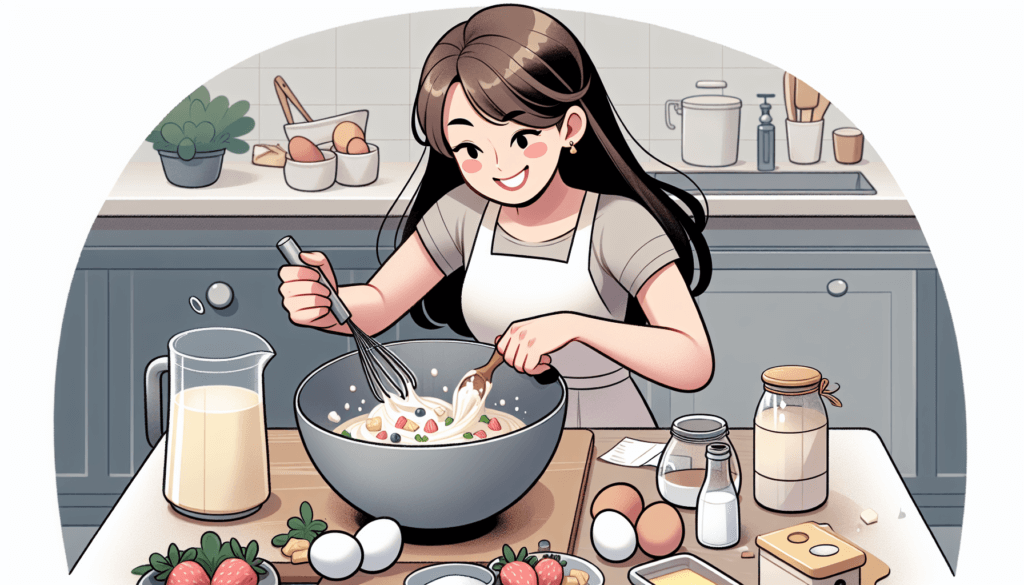Imagine the sheer delight of indulging in a creamy scoop of homemade ice cream on a sweltering summer day. Now, picture being able to create this frozen treat without the need for an expensive ice cream maker. Yes, you heard it right! In this article, we will reveal the secrets to making irresistibly creamy homemade ice cream using simple ingredients and a few clever techniques. Get ready to embark on a scrumptious journey filled with flavor combinations and endless possibilities. Prepare to impress your friends and family with your newfound skill in whipping up delectable frozen desserts that will have everyone begging for more. Let’s dive into the world of homemade ice cream, where the only limit is your imagination.
Ingredients
Making homemade ice cream without an ice cream maker is a fun and easy way to enjoy a sweet treat. Here are the basic ingredients you’ll need:
Heavy Cream
Heavy cream is the key component for achieving a rich and creamy texture in your homemade ice cream. It contains a higher fat content than regular milk, which contributes to the smoothness and richness of the final product.
Sweetened Condensed Milk
Sweetened condensed milk serves as the sweetener and base for your homemade ice cream. It adds a touch of sweetness and helps create a creamy texture when combined with the heavy cream.
Flavorings or Extracts
To personalize your homemade ice cream, you can add various flavorings or extracts. Options like vanilla, chocolate, strawberry, mint chocolate chip, butter pecan, salted caramel, coffee, raspberry swirl, or even peanut butter cup can be used to create endless flavor variations.
Mix-ins
Mix-ins are a great way to add extra texture and flavor to your homemade ice cream. Whether you prefer chunks of cookies, pieces of fruit, chopped nuts, or even candy, mix-ins can take your ice cream to the next level.
Method
Making homemade ice cream without an ice cream maker is simpler than you might think. Here’s a step-by-step guide on how to do it:
Whipping the Cream
In a large bowl, whip the heavy cream until it reaches stiff peaks. This will add air to the cream and create a light and fluffy texture in your ice cream.
Combining the Ingredients
Next, gently fold in the sweetened condensed milk until well incorporated. Be careful not to overmix as this can deflate the whipped cream.
Adding Flavorings or Extracts
At this stage, you can add your desired flavorings or extracts. Whether you want classic vanilla or something more adventurous like chocolate or strawberry, add a teaspoon or two and mix well.
Adding Mix-ins
If you’re looking to add some tasty surprises to your ice cream, now is the time to incorporate your mix-ins. Whether it’s crushed cookies, fruit, nuts, or candy, gently fold them into the ice cream mixture.
Freezing the Mixture
Transfer the mixture into a freezer-safe container with a tight-fitting lid. Cover the container and place it in the freezer for at least 6 hours or overnight to allow the ice cream to firm up.

Techniques for Creamy Texture
To achieve a creamy texture in your homemade ice cream, here are a few techniques you can try:
Whipping the Cream to Stiff Peaks
Whipping the cream to stiff peaks helps incorporate air into the mixture, resulting in a lighter and creamier ice cream texture. Be sure not to overwhip the cream, as it may become grainy.
Adding a Thickener
If you prefer a thicker ice cream consistency, you can add a thickener such as cornstarch or gelatin. These ingredients help bind the mixture and give it a smoother texture.
Using a Custard Base
Another way to achieve a creamy texture is by using a custard base. This involves cooking a mixture of milk, cream, sugar, and eggs until it thickens. The custard base adds richness and creaminess to the final ice cream.
Flavor Variations
The beauty of homemade ice cream is the endless flavor possibilities. Here are some popular flavors to inspire you:
Vanilla
A classic and timeless flavor, vanilla ice cream is a crowd favorite. You can use pure vanilla extract or even scrape out the seeds from a vanilla bean for a more intense flavor.
Chocolate
Everyone loves chocolate, and homemade chocolate ice cream is simply heavenly. Use high-quality cocoa powder or melted chocolate to achieve that rich and indulgent taste.
Strawberry
Fresh strawberries are a delightful addition to homemade ice cream. Blend or mash the strawberries and gently fold them into your ice cream mix for a burst of fruity goodness.
Mint Chocolate Chip
Perfect for mint lovers, this flavor combines refreshing mint extract with chocolate chips for a cool and indulgent treat.
Cookies and Cream
A classic combination, cookies and cream ice cream is made by folding crushed chocolate sandwich cookies into the base. The cookies add texture and a delicious cookie flavor to the ice cream.
Butter Pecan
For a nutty twist, try making butter pecan ice cream. Toasted pecans and buttery caramel swirls add a delightful crunch and depth of flavor.
Salted Caramel
Salted caramel ice cream is a delicious blend of sweet and salty. Make your own caramel sauce and add a sprinkle of sea salt for a heavenly treat.
Coffee
Coffee ice cream offers a rich and robust flavor for java lovers. Brew a strong cup of coffee and add it to the ice cream base, or use instant coffee for convenience.
Raspberry Swirl
Swirling raspberry sauce into your ice cream adds a tangy and fruity twist. Use fresh or frozen raspberries to create a vibrant and delicious flavor combination.
Peanut Butter Cup
Combine two favorites by folding chopped peanut butter cups into your ice cream. The creamy peanut butter and smooth chocolate pair perfectly in this flavor option.

Tips and Tricks
To ensure your homemade ice cream turns out perfect every time, here are some helpful tips and tricks:
Chilling Your Mixing Bowl and Whisk
Before whipping the cream, chill your mixing bowl and whisk in the freezer for about 15 minutes. The cold temperature helps the cream whip up faster and to a more stable consistency.
Adding Alcohol for Smoother Texture
Adding a small amount of alcohol, such as vodka or a flavored liqueur, to your ice cream base can help prevent it from freezing too hard. Alcohol lowers the freezing point, resulting in a smoother texture.
Covering the Ice Cream to Minimize Ice Crystals
To prevent ice crystals from forming on the surface of your ice cream, cover the container tightly with plastic wrap or a lid. This will help maintain the creamy texture.
Mixing Occasionally during Freezing Process
While the ice cream is freezing, remove it from the freezer every hour or so and give it a gentle stir. This breaks up any ice crystals that may have formed and ensures a smoother consistency.
Softening the Ice Cream before Serving
When it comes time to serve your homemade ice cream, let it sit at room temperature for a few minutes to soften. This makes scooping easier and allows the flavors to fully develop.
Common Mistakes to Avoid
Here are some common mistakes to avoid when making homemade ice cream without an ice cream maker:
Over-Whipping the Cream
While it’s important to whip the cream until it reaches stiff peaks, be careful not to overwhip it. Overwhipped cream can become grainy and create a less desirable texture in your ice cream.
Not Properly Combining the Ingredients
When folding in the sweetened condensed milk, be gentle to avoid deflating the whipped cream. Properly incorporating the ingredients ensures a smooth and creamy consistency.
Adding Too Many Mix-ins
While mix-ins can be tasty additions to your ice cream, adding too many can overwhelm the base and affect the texture. Be mindful of the balance between the ice cream and the mix-ins.
Skipping the Step of Freezing the Ice Cream Mixture
Allowing the ice cream mixture to freeze for the recommended time is essential. Skipping this step will result in a soft and soupy mixture instead of firm and scoopable ice cream.
Not Allowing Enough Time for Freezing
Homemade ice cream needs time to freeze properly and develop its desired texture. Be patient and allow for at least 6 hours or overnight in the freezer before enjoying your homemade creation.

Dairy-Free and Vegan Options
If you prefer dairy-free or vegan ice cream, there are alternatives you can use to achieve a similar creamy texture. Here are some options:
Coconut Milk or Cream
Coconut milk or cream is a popular choice for dairy-free ice cream. Its natural richness and fat content contribute to a creamy texture.
Cashew or Almond Milk
Cashew or almond milk can also be used as a base for dairy-free ice cream. These nut milks have a creamy consistency and work well with various flavors.
Non-Dairy Milk and Thickeners
Non-dairy milks such as soy or oat can be combined with thickeners like arrowroot powder or cornstarch to create a similar texture to traditional ice cream.
Non-Dairy Flavors and Mix-ins
When it comes to flavor variations and mix-ins, there are numerous non-dairy options available. From vegan chocolate chips to dairy-free fruit purees, you can customize your ice cream to suit your preferences.
Serving and Storage
Once your homemade ice cream is ready, here are some serving and storage tips:
Serving Suggestions
Homemade ice cream is versatile and can be enjoyed in various ways. Scoop it into cones, serve it in bowls with toppings like chocolate sauce or sprinkles, or use it to make ice cream sandwiches. The possibilities are endless!
Storing the Homemade Ice Cream
To keep your homemade ice cream fresh and creamy, store it in a lidded container in the freezer. Be sure to press a sheet of plastic wrap onto the surface of the ice cream before covering to prevent ice crystals from forming.

Conclusion
Making homemade ice cream without an ice cream maker opens up a world of creativity and flavor possibilities. With just a few simple ingredients and techniques, you can whip up a batch of rich and creamy ice cream that rivals any store-bought variety. Experiment with different flavors, mix-ins, and techniques to create your perfect frozen treat. So grab your mixing bowl, whip up some heavy cream, and indulge in the deliciousness of homemade ice cream. Enjoy!


